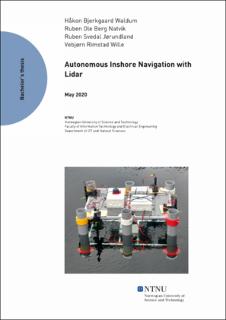| dc.contributor.advisor | Osen, Ottar L. | |
| dc.contributor.advisor | Bye, Robin T. | |
| dc.contributor.author | Waldum, Håkon Bjerkgaard | |
| dc.contributor.author | Jørundland, Ruben Svedal | |
| dc.contributor.author | Natvik, Ruben Ole Berg | |
| dc.contributor.author | Wille, Vebjørn Rimstad | |
| dc.date.accessioned | 2020-07-09T16:01:21Z | |
| dc.date.available | 2020-07-09T16:01:21Z | |
| dc.date.issued | 2020 | |
| dc.identifier.uri | https://hdl.handle.net/11250/2663588 | |
| dc.description.abstract | Denne rapporten omhandler utviklingen av en prototype som autonomt skal navigere og legge til kai ved bruk av Lidar som syn. Poenget i denne undersøkelsen er å utforske hvordan man implementer et slikt system, og hvor brukbart det er for autonom navigasjon og det å legge til kai autonomt.
En prototype basert på et semi-submersible design har blitt utviklet og blitt utstyrt med en Lidar og andre sensorer for å nå dette målet.
Prototypen har fire motorer som gjør det mulig å kjøre i alle horisontale retninger.
Resultatet av å teste prototypen viser at systemet klarer å navigere i små områder hvor Lidaren har god nok rekkevidde til å finne flater i nærheten til å lokalisere seg selv.
Den har imidlertid problemer med å unngå hindringer pga. for lite datakraft. Et annet problem er at Lidaren som er brukt ikke var kraftig nok til å kunne brukes utendørs i store områder siden den sliter med rekkevidde som gjør at det er vanskelig å lokalisere seg. Systemet gir fortsatt gode forhåpninger og fungerer bra i mindre områder med mange reflekterende flater innen rekkevidde for Lidaren. | |
| dc.description.abstract | This report concerns the development of a prototype that should autonomously navigate and dock using a Lidar for vision. The purpose of this project is to investigate how to implement such a system, and how viable it can be for autonomous navigation and docking of vessels.
A prototype based on a semi-submersible design was developed and equipped with a Lidar and other sensors and equipment to achieve this.
The prototype has four thrusters enabling movement in all horizontal directions.
The results from testing this prototype show that the system is capable of navigating through smaller areas, where the Lidar has good enough range to find reference surfaces to localize itself.
It does however struggle with obstacle avoidance due to a lack of processing power. Another issue is that the Lidar used was not powerful enough to be used outdoors in larger areas due to a lack of range and therefore reference surfaces for localization. Even still the system shows great promise and worked well in a smaller area with enough references for the used Lidar's range. | |
| dc.publisher | NTNU | |
| dc.title | Autonomous Inshore Navigation with Lidar | |
| dc.type | Bachelor thesis | |
